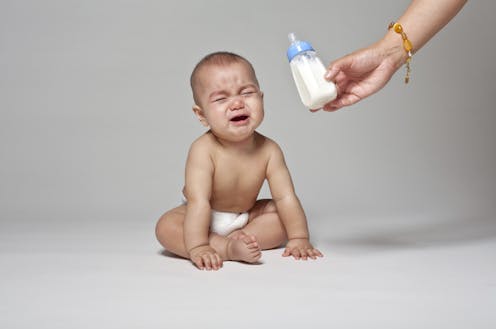Hey, new parents – go ahead and 'spoil' that baby!
A professor of child development explains why it’s OK – recommended, in fact – to respond to an infant’s every cry, sob and whimper.

When an infant cries, parents frequently wonder whether they should soothe the baby or let the baby calm itself down. If they respond to every sob, won’t the baby cry more? Isn’t that spoiling the baby?
I hear these questions a lot as a professor of child development and family science. The notion of spoiling a baby remains common in the U.S., despite evidence that infants who have parents who respond to their needs are better at calming themselves down later in life.
Many of the students I teach say that their parents resisted calming their cries and that they turned out just fine. Of course, there are individual differences in early childhood development. There is no “one size fits all” for parenting.
That said, for decades now, developmental scientists have studied emotional regulation in children and the caregiver-infant bond. There is an answer to the common question of whether it’s better to comfort a crying baby or let them learn to calm themselves down. Let me explain …
Emotional regulation during infancy
Infants are born with a remarkable number of capabilities. Indeed, research shows that babies seem to “know” a lot more about the world we live and grow in than previously believed. For instance, infants possess an understanding of numbers, object permanence and even morality.
However, infants’ abilities are still immature. They rely on their caregivers to fine-tune those skills, much like other young mammals.
And one thing newborns cannot do is regulate their own distress – whether that distress comes from feeling cold, hunger, pain or any other discomfort. That ability does not develop until approximately 4 months of age. So infants need their parents’ help to calm down.
Since crying is one of the first ways infants communicate their needs to caregivers and others, it is imperative for the infant-parent bond that caregivers respond to their infant cries.
Moreover, research shows that infant cries elicit an apparent psychological need in others to ease their distress. As such, infant cries serve a fundamental purpose for both infant and caregiver.

Critically, infants also learn from the responsiveness of their caregivers what it feels like to calm down. This feeling is similar to the internal changes that adults and older children feel when they regulate their emotions – that is, their heart rate slows and they feel at ease. This repeated experience gives infants new life skills: Longitudinal research indicates that infants whose caregivers respond to their distress are better able to regulate emotion and behavior as they get older.
For babies, self-soothing likely means sucking on a pacifier or a fist. Later in life, those foundational infant calming skills learned in response to parental care develop into more adultlike habits for regulating distress, like counting to 10 or taking deep breaths.
Caregiver-infant bonding
Parental responsiveness to infant cries also affects the infant-caregiver relationship. Caregivers provide the first information for infants about the predictability of the social world, the trustworthiness of others and about their own self-worth.
This lays the foundation for the quality of the lifelong relationship between a caregiver and child. When infants are soothed in times of distress, they learn that their caregiver is trustworthy and reliable. They also learn that they are worthy of caring, loving relationships, which positively influences their future relationships.
Caregiver responsiveness is also associated with a cascade of well-documented outcomes in infants, children and adolescents, including cognitive functioning, language development, self-esteem and future sensitivity to infant needs.
The absence of caregiver responsiveness, on the other hand, is linked to later behavioral difficulties and developmental challenges. Studies show that neglected children can struggle to bond with their peers and to cope with rejection.
Though one study recently reported that these ill effects might not apply at night – as in, when parents let babies “cry it out” to teach them to sleep – the major consensus in the literature is that before 4 months of age babies should not be left to cry. I recommend no earlier than 6 months because of the formation of the attachment bond, and highly encourage caregivers to consider the individual abilities of their child. Indeed, some children are able to self-regulate better than others. In addition, there are alternative ways to help babies learn to self-soothe at night that include responding to infant distress.
Fortunately, caregivers are biologically primed to care for their infants. Research with animals and humans demonstrates that there are hormones that drive caregiving.
Go ahead, ‘spoil’ that baby
My best advice, based on the scientific literature, is that parents should respond promptly and consistently to infant cries through at least 6 months of age.
But take a pragmatic approach.
Caregivers know the idiosyncrasies of their infants: Some may be more placid, while others are more excitable. Likewise, culture drives the goals caregivers set for themselves and their children. So, responsiveness and adaptive caregiver-infant relationships will look different for different families. Parents should act accordingly, fitting their responsiveness to their infant’s needs and their cultural context.
However you look at it, responding to an infant’s every cry is not “spoiling” the baby. Instead, the act of soothing a crying infant provides the baby with the tools they will use to soothe themselves in the future.
Amy Root receives funding from National Institute of Child Health and Human Development.
Read These Next
Who thinks Republicans will suffer in the 2026 midterms? Republican members of Congress
The president’s party almost always loses seats in the midterms. More than two dozen Republican House…
How the ‘slayer rule’ might play a role in determining who will inherit wealth from Rob Reiner and h
These rules have a long history in the United States. They played a role in the notorious murders by…
The celibate, dancing Shakers were once seen as a threat to society – 250 years later, they’re part
‘The Testament of Ann Lee,’ Mona Fastvold’s 2025 film, depicts part of the long history of Shaker…






